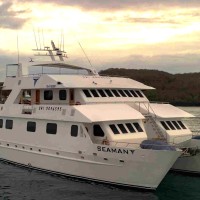Galapagos: Seaman Journey | 9 days
Tour Overview
Discover the Galapagos Islands on this 9 days itinerary on the M/C Seaman, encompassing Genovesa, Santa Cruz, Santa Fe and San Cristobal Islands.
You can hike, swim, paddle, snorkel and cruise among the incredible and abundant natural life of the Galapagos Islands. Known as a birder's paradise - your Galapagos Islands vacation will be dotted with bird watching opportunities. Frigate birds display proudly on North Seymour, Galapagos Hawks circle above Santa Fe and the most populated island of all, Genovesa, teems with thousands of birds. Joining them on lava outcrops, in azure blue waters and among secluded mangroves live sea lions, crabs, marine iguanas, sea turtles, giant tortoises and so much more.
Your Galapagos cruise takes you to Santa Fe where you may snorkel with playful sea lions and to Plazas where you might spot the curious cross between land and marine iguanas. Visit the Galapagos Islands on board the well-appointed M/C Galapagos Seaman and enjoy the amenities of the catamaran and the delicious fine dining & cuisine onboard. The experienced crew will impress with their vast knowledge of the Galapagos National Park.
Viva's Best Bits...
Great itinerary for birdwatchers! Look out for the three different species of Bobbies; the Blue footed, Red footed and Nazca booby on Genovesa!
Walk along the volcanic rock trail where due to natural erosion two species of petrels have built their nesting sites.
"Snorkel with playful sea lions and tropical fish on Santa Fe. The sea lions are so curious and fun, it will always be one of my favourite memories!" Tara, Team Viva



